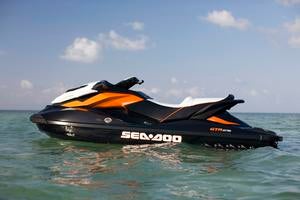2012 Sea-Doo GTR 215 Review
Big power and light weight make for a fun PWC
Sea-Doo is often at the cutting edge of design and technology, but the company is also not one to shy away from borrowing another manufacturer’s best ideas. Following Yamaha’s big-horsepower-in-a-lightweight-inexpensive package VXR in 2011, Sea-Doo has done likewise for 2012, placing a 215hp motor in its recently retooled, recreational-level GTI line to create the all-new GTR 215.
The result is similar to what Yamaha discovered last season — horsepower and simplicity prove to be one fun package.
Need For Speed
 Sea-Doo’s new GTR 215 offers users a powerful engine and lightweight hull, which combine to make a really fun PWC.
Sea-Doo’s new GTR 215 offers users a powerful engine and lightweight hull, which combine to make a really fun PWC.As the name makes obvious, the engine in question is Sea-Doo’s 215hp variant of the Rotax 4-TEC. Those familiar with the engine will notice one obvious fact: Sea-Doo’s answer to the big power/light hull question includes a supercharger/intercooler combo. That addition gives the boat a strong punch out of the hole, and thrilling acceleration through the midrange of the powerband. Top speed on my test boat was almost 65 mph on the nose. Keep in mind, this is the same powerplant found in a long-popular GTX model. Here, with a weight savings of about 60 pounds it feels that much more potent.
And makes the hull that much more playful. I was impressed with the GTI makeover of 2011, but the added horsepower truly brings this hull to life. I found the hull powered through turns with gusto, yet never threw out any quirks to make me question my control. Top-speed stability also seemed equally strong. It’s a confidence-inspiring ride that, as I noted in a recent 2012 lineup overview, is one that Sea-Doo insiders often choose for long-distance riding.
 A touring seat helps lock the pilot into place for aggressive riding.
A touring seat helps lock the pilot into place for aggressive riding.Certainly the hull is familiar. It’s the same one that graced the previous generation GTI, and one of the few elements retained in last-year’s full-scale makeover. Last year’s improvements, however, have made this looser-feeling ride even more attractive. While the hull sports the same shallower, 16-degree deadrise, it’s longer in the bow area to match the upper deck and includes spray-reducing chines. Some added length at the stern also increases buoyancy.
Up top, find the familiar tweaks of 2011. A shorter height lowers the center of gravity, while footwells flow in a smooth arc, and are canted inwards to take stress off the knees and aid comfort. A narrower seat allows more comfortable stand-up riding.
Feature Rich
 Riders can choose between Sport, Touring and ECO modes.
Riders can choose between Sport, Touring and ECO modes.If the power and agility don’t grab your attention, the extras may. Whereas Yamaha took a simpler-is-better approach to the VXR, Sea-Doo is banking on a few bells and whistles.
Intelligent Brake and Reverse (iBR) offers significant stopping power by using a reinforced reverse bucket as a brake. It cuts straight-line stopping distance by roughly 50-percent. The setup also allows the boat to start in a neutral mode at the dock, then be shifted into forward and reverse for a level of control unmatched by most competitors. Electronic throttle also allows for two operational “modes” — sport or touring. The former gives the operator full access to the craft’s power, the latter tames things down for newcomers or those who may want a less aggressive ride. There’s also an ECO mode for best fuel economy.
High-performance variable trim also finds a home on the craft. I like its quick response, especially the fact you can “double-tap” to immediately go to one of two presets and keep your eyes on the water. Trim allows you to plant the nose for best cornering, yet raise the bow to achieve best top speed.
The GTR also gets the bolstered touring seat, not so much because it’s ready to haul you long distance, but more to give the support and locked-in feel that aggressive riders prefer. And speaking of aggressive, the craft looks the part of a musclecraft as well, dressed up in black with orange and white accents.
Cheap Speed
Cost? Sea-Doo settled on $11,499, just $200 more than the Yamaha VXR it will certainly be compared to. Both put out flagship numbers, edging beyond the 65mph mark, for far less than the typical flagship price. Of the pair, Sea-Doo certainly offers more features, while Yamaha opts for a more simplistic approach.
I’d strongly suggest trying both if possible. Each has a personality…
…not to mention the power to back it up.
| 2012 Sea-Doo RXP-X 260 Review Specs | |
| Length | 132.6 inches |
| Beam | 48.5 inches |
| Dry Weight | 765 lbs |
| Engine | Three-cylinder EFI, Supercharged w/intercooler |
| Displacement | 1,494 cc |
| Bore and Stroke | 100 mm x 63.4 mm |
| Compression Ratio | 8.4:1 |
| Rated Horsepower | 215 |
| Fuel Capacity | 15.9 gal. |
| Combined Stowage Capacity | 30.8 gal. |
| Colors | Orange Burst |
| Price | $11,499 |
Related Reading
2012 Sea-Doo PWC Lineup Preview
2012 Sea-Doo RXP-X 260 Review
2011 Sea-Doo GTX iS 215 Review
2010 Sea-Doo RXT 215 Review
2011 Yamaha VXR Review
Get PersonalWatercraft.com in your Inbox!
Like PersonalWatercraft.com on Facebook
Comments
Most Popular

Remembering the Sea-Doo XP

2025 Yamaha JetBlaster PRO 2-Up Review

2024 Yamaha VX Cruiser HO Review

Electric Sea-Doo Coming By 2026

2025 Yamaha JetBlaster Review














 Your Privacy Choices
Your Privacy Choices